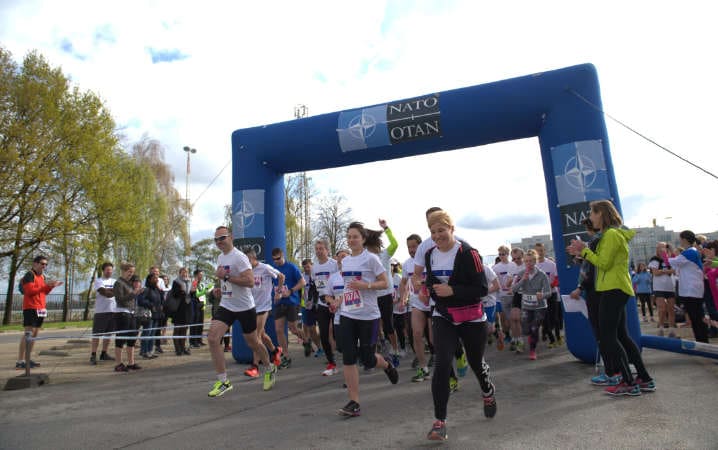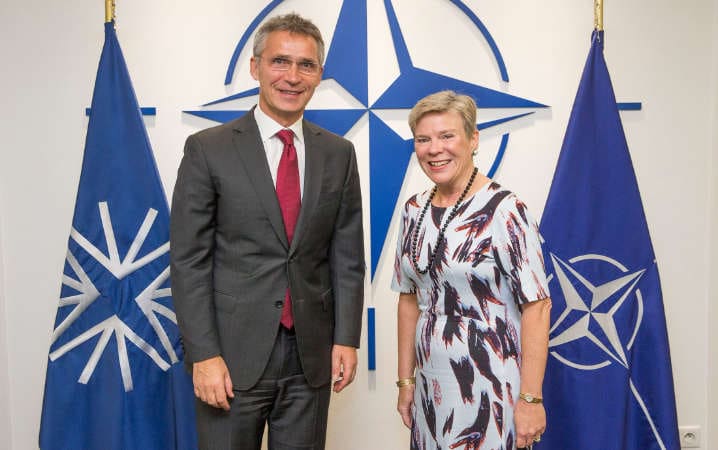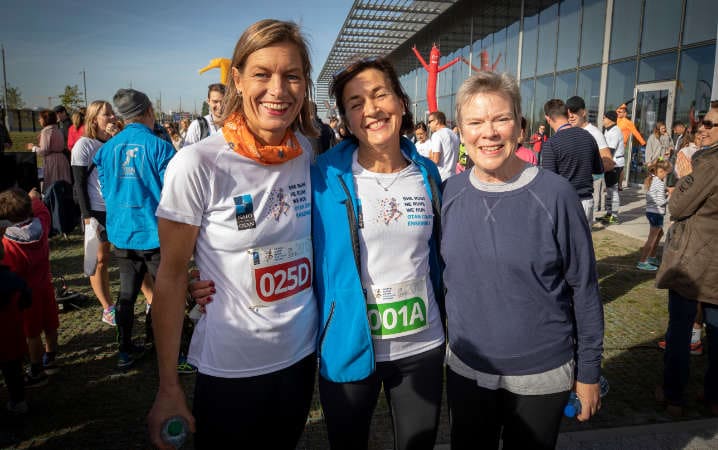Diversity does not happen on its own. It needs to be driven by political will and good intentions enabled and, most importantly, momentum must be maintained. This is not just a question of having the right regulations, policy frameworks and directives in place. Champions are needed, who create a spirit of inclusion, at all levels of an organisation. This is particularly true at NATO, given that defence and security have traditionally been perceived as a male domain.
To mark International Women’s Day, let us take a quick look at how far NATO has progressed in promoting gender balance.

Participants cross the finish line of NATO’s “She Runs, He Runs, We Run” mixed relay event, which brings together participants of all ages and ranks, as well as their family members – 2017. © NATO
What do the figures say?
Based on figures from the 2017 Annual Diversity and Inclusion Report, at the NATO-wide level:
- Women represent 26 per cent of just over 5,700 civilian staff employed across NATO entities.
- Allied Command Operations, NATO Headquarters and the NATO Support and Procurement Agency have relatively higher proportions of female civilian employees (38 per cent, 39 per cent and 29 per cent respectively) compared to other NATO entities. However, the majority of female civilian staff are employed in support and administrative positions.
- Over the last ten years, the proportion of women serving in the International Staff at NATO Headquarters has increased gradually from 36 to 39 per cent. However, as is the case NATO wide, most women are in support and administrative positions rather than in managerial and senior leadership positions.
- Women represented 20 per cent of senior leadership (section managers and above) at NATO Headquarters in 2017, which is a nine per cent increase since 2002. The figures for 2018 indicate a slight rise in the percentage of women overall at 40 per cent and 25 per cent in senior leadership positions. Other NATO entities have little-to-no senior positions filled by female civilian staff.
When compared to the same grade levels in the United Nations system, NATO has some catching up to do in terms of senior leadership. There, women’s representation overall is 43 per cent and 35 per cent in senior leadership positions (P5 and above).
Trailblazers at senior level
Among female senior decision-makers currently serving at NATO, Deputy Secretary General Rose Gottemoeller, appointed in 2016, is the highest ranked civilian woman ever. She has a long career in the security field, notably arms control, having most recently served for nearly five years as the Under Secretary for Arms Control and International Security at the United States Department of State.

NATO Secretary General Jens Stoltenberg welcomes Rose Gottemoeller to NATO on her first day as Deputy Secretary General
– 17 October 2016. © NATO
Clare Hutchinson, who took up her post in 2018, is the third woman to serve as the Secretary General’s Special Representative for Women, Peace and Security (WPS), following on from Marriët Schuurman and Mari Skåre. The Special Representatives have played a key role in advocating for women’s inclusion at NATO and in mainstreaming gender perspectives across NATO policies and activities, as well as working to advance the WPS agenda with Allies and partner countries, other organisations and civil society. Ms Hutchinson previously served for over a decade as Senior Gender Adviser with the United Nations.
Former BBC journalist Oana Lungescu, appointed in 2010, is the first female NATO Spokesperson. In 2016, Politico named her one of the most influential women in Brussels.
Wendy Bashnan became the first female Director of the NATO Office of Security in 2017. Prior to this, she served for many years in the United States Bureau of Diplomatic Security, most recently as Executive Assistant to the Assistant Secretary.
Among past NATO senior leaders, Kolinda Grabar-Kitarović was the first ever female Assistant Secretary General to be appointed, in 2011. She had previously been Croatia’s Minister of Foreign Affairs and European Integration as well as Ambassador to the United States – and she went on to become the first woman to be elected President of her country.
The fact that we can count the women currently in senior decision-making positions on one hand shows that NATO still has a long way to go in terms of gender balance at this level. Nevertheless, these trailblazers are all champions of diversity and inclusion, and role models of inclusive leadership. Moreover, they have helped give NATO a ‘female face’ in public, which is an important signal of change.

NATO’s civilian and military decision-makers address the issue of sexual violence in conflict, during a visit of United Nations High Commissioner for Refugees Special Envoy, Angelina Jolie – 31 January 2018.
(Left to right: NATO Deputy Secretary General Rose Gottemoeller; Angelina Jolie; NATO Secretary General Jens Stoltenberg; Clare Hutchinson, NATO Special Representative for Women, Peace and Security; Grethe Horgen, Deputy Secretary of the Council; General Petr Pavel, Chairman of the NATO Military Committee; and General Curtis Scaparrotti, Supreme Allied Commander Europe) © NATO
Laying the groundwork
Of course, diversity is about more than gender balance. NATO seeks to provide equal opportunities and a workplace free from discrimination for staff regardless of sex, race, ethnic origin, religion, beliefs, nationality, disability, age or sexual orientation.
Allied leaders, meeting at the Prague Summit in 2002, specifically tasked NATO’s International Staff to find ways to encourage the recruitment, retention and professional development of a diverse workforce. By the end of 2003, NATO had agreed on changes to its regulations for civilian personnel, and on policies on equal opportunity and diversity (noted by all NATO entities in 2007) and on protection against discrimination and harassment at work.
These policies are cornerstones of gender balance and diversity initiatives within NATO. Over the years, implementation has been supported by a series of action plans. These have aimed to develop a merit-based recruitment system to attract high-quality personnel, while respecting the diversity of Alliance members; mainstream NATO’s equal opportunities and diversity policy framework; and improve the NATO work environment.
In 2012, gender neutral text was adopted throughout the civilian personnel regulations, including a definition of spouse. Moreover, civil registered partnerships are now recognised, when partners do not have legal access to civil marriage. A teleworking policy, proposed by staff, was agreed and adopted NATO-wide, enabling certain staff to work from home and promoting opportunities to improve work-life balance.
In 2013, the North Atlantic Council endorsed the NATO Code of Conduct which entailed promoting the highest levels of trust and confidence in our integrity, impartiality, loyalty, accountability and professionalism.
Fostering inclusion
An important element that plays a crucial role in attracting and retaining a talented workforce is inclusion. This means creating a work environment that is supportive of its diverse workforce, in which all individuals are treated fairly and respectfully, have equal access to opportunities and resources, and can contribute fully to the Organization’s success.
NATO must do more than provide numbered results of its diversity footprint. Inclusion practices are much more difficult to measure but can improve motivation, cooperation and innovation in staff. This is indeed a challenge but one that NATO is taking on. In recent years, a number of initiatives have sought to make staff feel more included, more valued for their differences.
A Mentoring Programme for women working at NATO Headquarters was launched in 2015 to further increase the pool of qualified female candidates and to remove potential internal, structural barriers within different services and types of staff, which may prevent women from advancing within the Organization. Applications are received for both mentors and mentees. Mentees can be women of any grade or rank in any service (civilian or military), whether they be NATO staff, personnel seconded from NATO member states, delegates, consultants, temporary staff or interns. All mentors and mentees receive training in the form of a half-day workshop.
The third cycle of the Programme (2017/2018) had 110 participants, approximately 50 mentors and 60 mentees, about the same level of participation as in 2016. It is encouraging to see that both women and men (60 per cent of mentors were male) were engaged in this initiative at various levels, and that 36 per cent were managers, ranging from the level of section head all the way up to senior decision-makers.
The Mentoring Programme is set to continue annually and to be reviewed regularly based on lessons learned from previous cycles. Moreover, an internal communication tool, the NATO Women’s Professional Network has been set up to enable mentoring opportunities, information sharing, blogging, and the organisation of events and guest speaker sessions.
Young professionals were the focus of another event at NATO Headquarters in 2017. Initiated by the Deputy Secretary General and representatives of Canada and the Netherlands with the support of the Office of Women Peace and Security, it aimed to show the value and importance of having a broad age distribution among staff. The event sought to actively connect with young people, to foster a spirit of inclusion and to brainstorm on how to further encourage the employment of young people. The average age in the International Staff is 48, with only 12 per cent aged 35 and under.

Champions of diversity support the 2018 “She Runs, He Runs, We Run” event.
(Left to right: Marriët Schuurman, former NATO Special Representative for Women, Peace and Security; Anne Rosner, President of the NATO Cultural and Sports Club and passionate marathon runner, who came up with the idea for this event;
and NATO Deputy Secretary General Rose Gottemoeller) © NATO
Sports also provide opportunities to promote diversity and inclusion. For the last three years, “She Runs, He Runs, We Run” has brought together participants of all ages and ranks, as well as their family members. The event seeks to raise awareness of United Nations Security Council Resolution (UNSCR) 1325 on Women, Peace and Security, to promote gender balance within NATO and to encourage the role of sports in empowering women and girls. The run is a symbolic distance of 13.25 km and has to be achieved in mixed teams running the distance in relay.
NATO has also learned from the #MeTooCampaign and a thorough review of its policy on the Prevention and Management of Harassment, Bullying and Discrimination in the Workplace was conducted by an independent expert who provided very helpful recommendations in January 2019. The implementation of this policy and follow-on recommendations will support the NATO Secretary General’s strong commitment to zero tolerance regarding inappropriate behaviour in the workplace.
What’s next?
This year, NATO will put forward a new Diversity and Inclusion Action Plan in cooperation with the Special Representative for Women, Peace and Security. The main drivers of the new Action Plan will be recruitment, training and inclusive leadership.
To succeed, efforts to mainstream gender and diversity have to be visible and accompanied by high-level support and commitment. When leaders demonstrate commitment to diversity and inclusion, it gives a positive message to staff and impacts organisational culture. Inclusive leaders play an important role in removing institutional barriers to diversity and highlighting the benefits that diversity can bring to the Organization. Diversity is not only something that should be tolerated, but is a true asset. Diversity and inclusion contributes to keeping employees motivated, increases productivity and achieves better results.
Hiring practices and talent management are two important elements in the Action Plan that will help NATO to recruit diverse and talented staff. Barriers may still exist in job vacancies themselves, in particular with respect to the number of years of experience required (a barrier to young talent), specific NATO or military experience, or posts where previous deployment to operational theatre is essential (a potential barrier to external applicants, civilians in general).
NATO must focus on reaching out internally and externally to candidates who would best fit the diverse profiles and vacancies, and encourage them to apply. For example, Human Resources is committed to helping remove the perceived language barriers by communicating to potential candidates that the language requirements for both English and French are a developmental opportunity rather than an obstacle. NATO should also concentrate its efforts on advertising itself as an attractive employer to external candidates in terms of its compensation and benefits package, and policies to promote diversity and inclusion, and work-life balance.
Education and training help raise awareness and enable changes in mindset to achieve the desired diverse and inclusive organisational culture. The benefits of diversity-related training include increasing engagement of employees and managers, improving morale, and reducing the risks of workplace harassment.
Incorporating the diversity and gender balance perspective into all policies, processes and implementation requires both individual and collective efforts at every level, NATO wide. The policy framework and directives are firmly in place to enable gender balance and diversity and are continuously evolving. However having dedicated champions, especially those that practice inclusive leadership, and having support from NATO member states are essential to keep up the momentum. NATO is on the right path, but still has work to do. It is a very challenging, but exciting journey.
